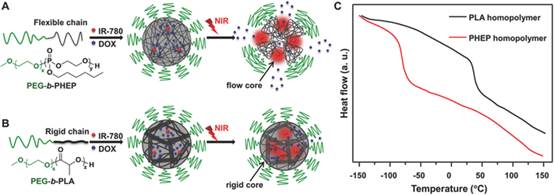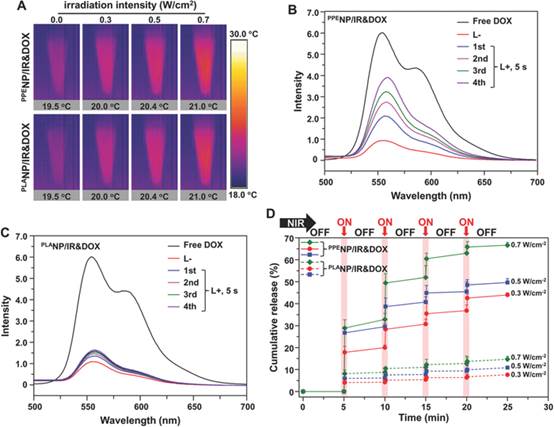


合肥工业大学一项研究发现,通过光热试剂在近红外光照射下产生的光热效应,能触发化疗药物从黏流态高分子纳米药物载体中超敏释放,显著增强对肿瘤生长的抑制效果。成果发表在《先进功能材料》期刊。
最新研究发现,高分子纳米药物富集在肿瘤部位并被肿瘤细胞摄取后,需要从纳米载体中快速释放才能达到更有效的肿瘤杀伤效果,而目前临床使用的聚乳酸体系高分子纳米药物无法实现这一需求。
该校纳米医学和生物材料团队通过包载光热试剂和化疗药物阿霉素得到共负载纳米体系,其内核高分子材料玻璃化转变温度低至-81.8°C。在近红外光照射5秒后,纳米颗粒溶液温度微弱上升0.5°C~1.5°C,并触发化疗药物的快超敏释放。实验表明,在肿瘤部位化疗药物富集基本相当的情况下,近红外光触发的化疗药物超敏释放,能显著增强抑制肿瘤生长能力。32天治疗结束后,聚磷酸酯纳米载体实验组小鼠肿瘤体积仅为聚乳酸纳米实验组的1/3。
而在目前临床上使用的第一代聚乳酸高分子纳米药物中,由于聚乳酸的玻璃化转变温度高达40.2°C,在光热转化时聚乳酸链段仍处于玻璃态,整个高分子链不能运动,从而导致化疗药物运动被阻止,这种超敏释放效应并未观察到。(来源:中国科学报 周慧 杨保国)
NIR-Activated Supersensitive Drug Release Using Nanoparticles with a Flow Core
Abstract Near infrared (NIR) light-activated supersensitive drug release via photothermal conversion is of particular interest due to its advantages in spatial and temporal control. However, such supersensitive drug release is rarely reported for polymeric nanoparticles. In this study, polymeric nanoparticles observed with flowable core can achieve NIR-activated supersensitive drug release under the assistance of photothermal agent. It is demonstrated that only 5 s NIR irradiation (808 nm, 0.3 W cm−2) leads to 17.8% of doxorubicin (DOX) release, while its release is almost completely stopped when the NIR laser is switched off. In contrast, the control, poly(d,l-lactide) nanoparticles with rigid cores, do not exhibit such supersensitive effect. It is demonstrated that intraparticle temperature is notably increased during photothermal conversion by detecting fluorescein lifetime using a time-correlated single photon counting (TCSPC) technique, which is the main driving force for such supersensitive drug release from hydrophobic flow core. In contrast, rigid chain of nanoparticular core hinders drug diffusion. Furthermore, such NIR light-activated supersensitive drug release is demonstrated, which significantly enhances its anticancer efficacy, resulting in overcoming of the resistance of cancer cells against DOX treatment in vitro and in vivo. This simple and highly universal strategy provides a new approach to fabricate NIR light-activated supersensitive drug delivery systems.
原文链接:http://onlinelibrary.wiley.com/doi/10.1002/adfm.201603195/pdf



